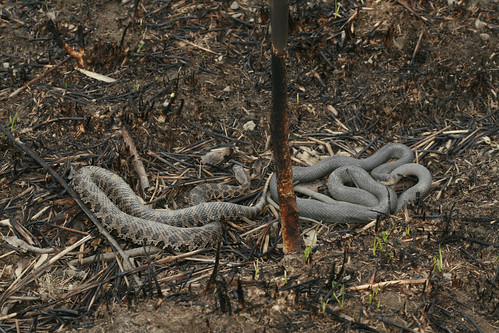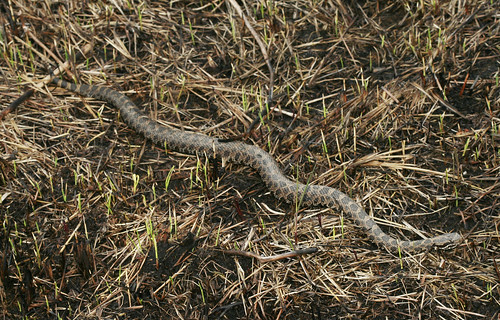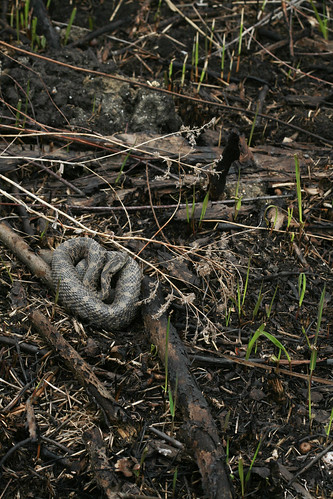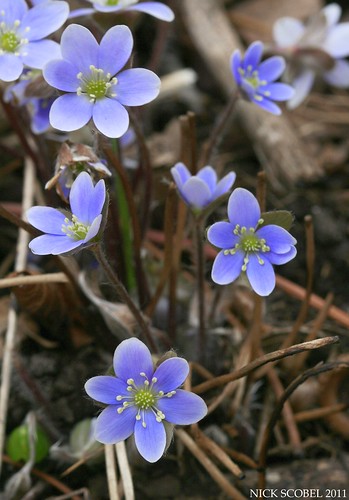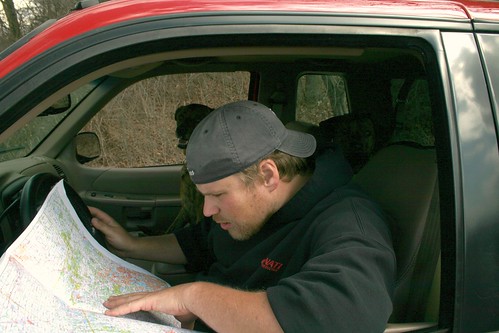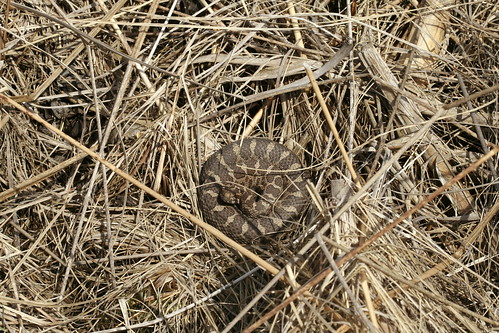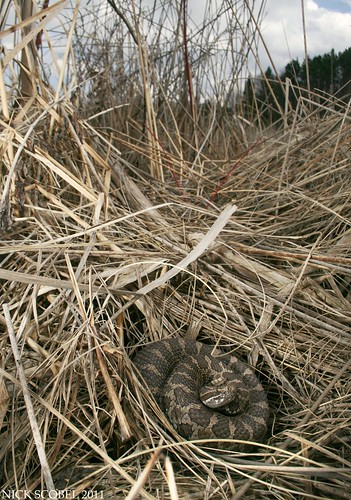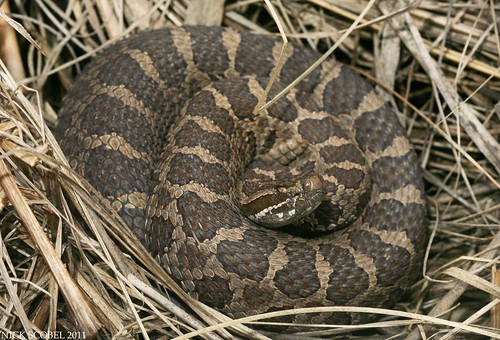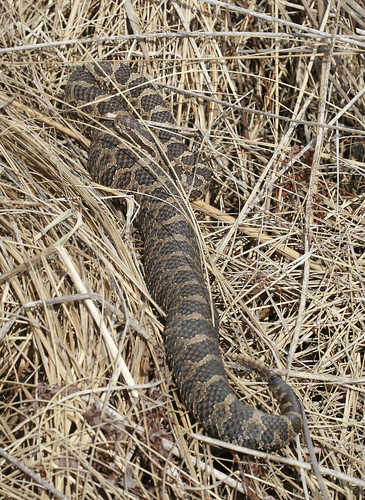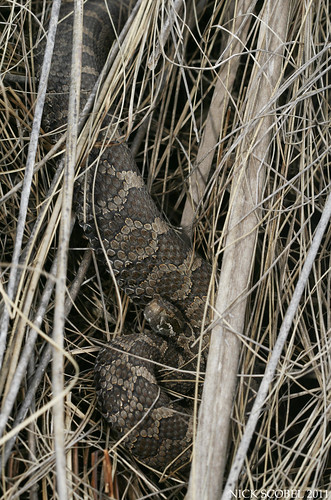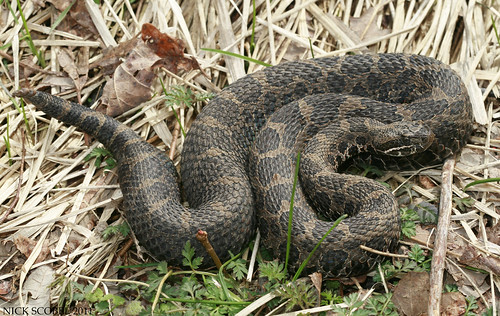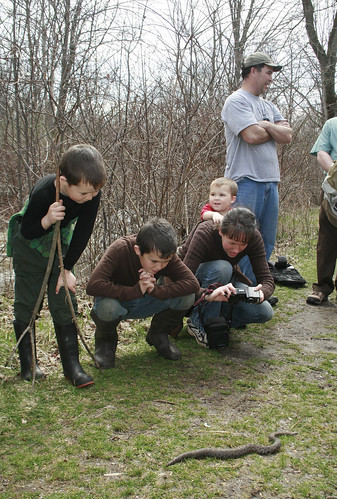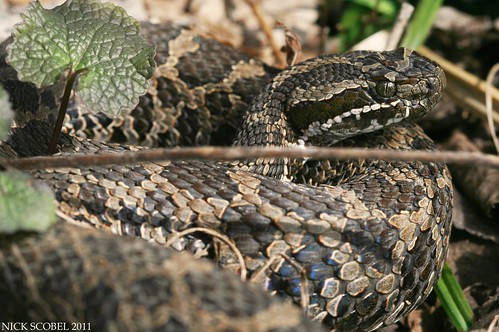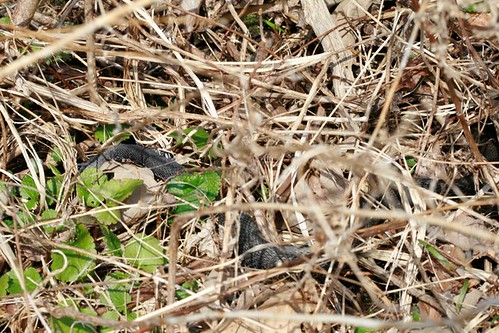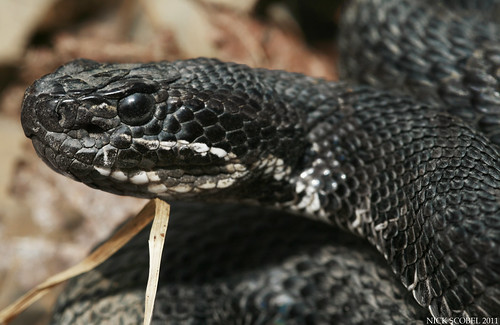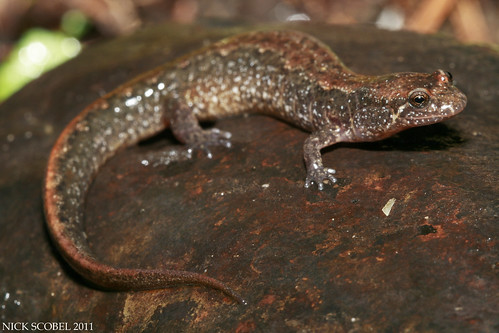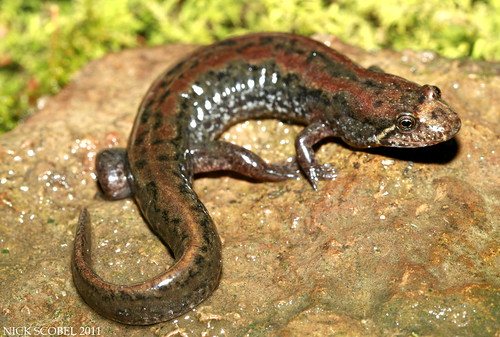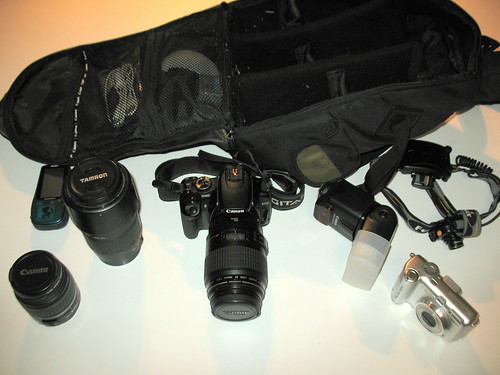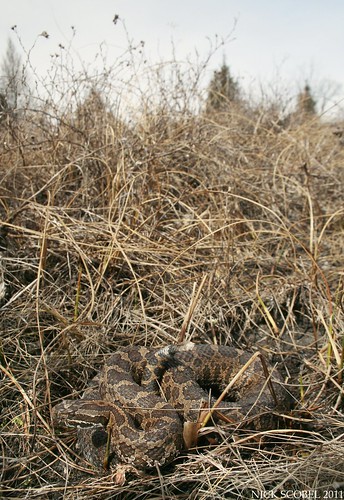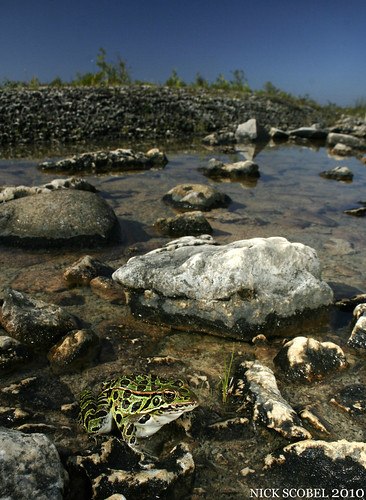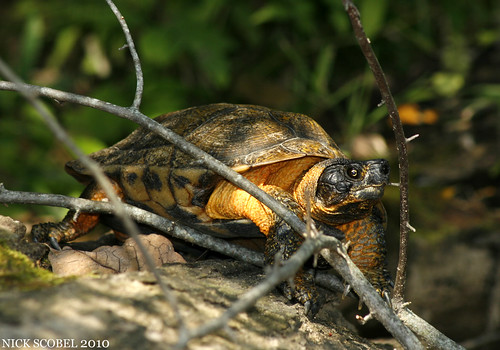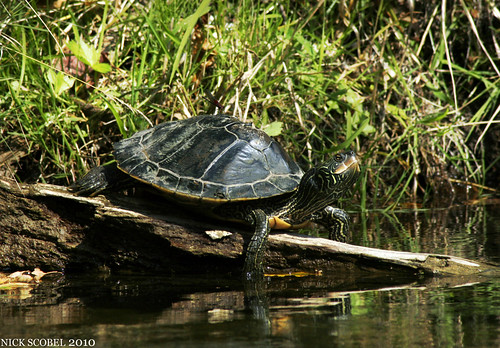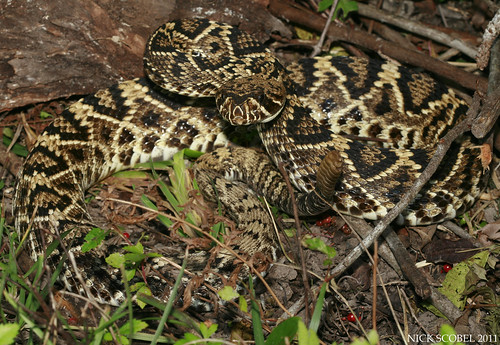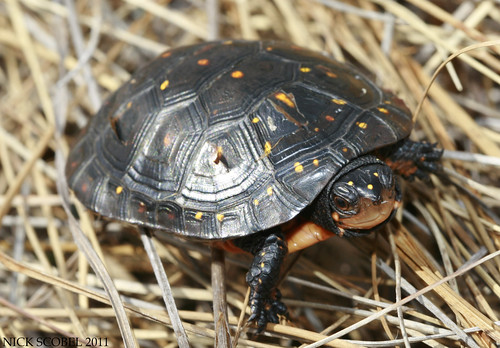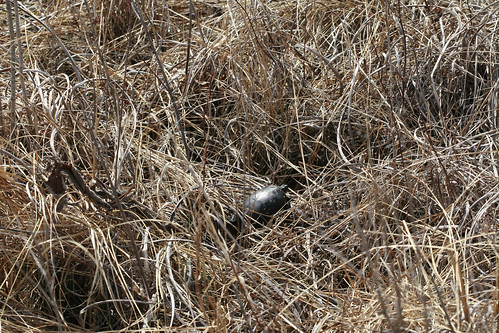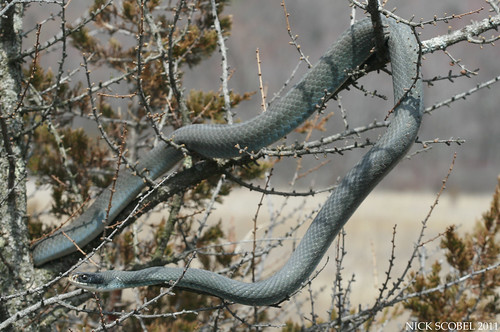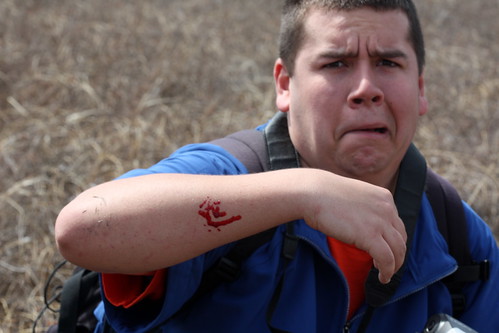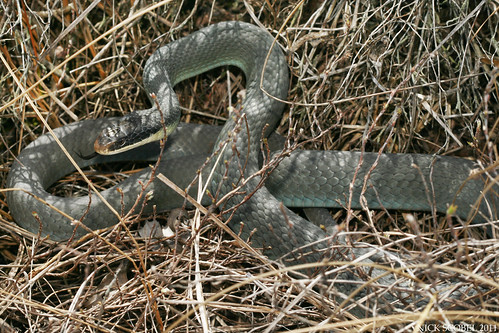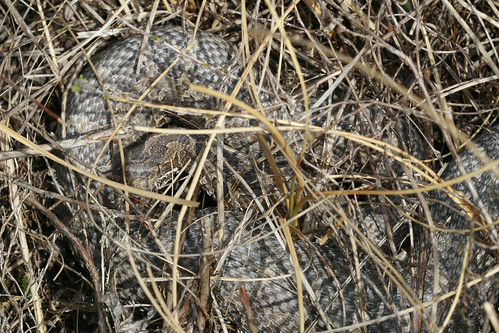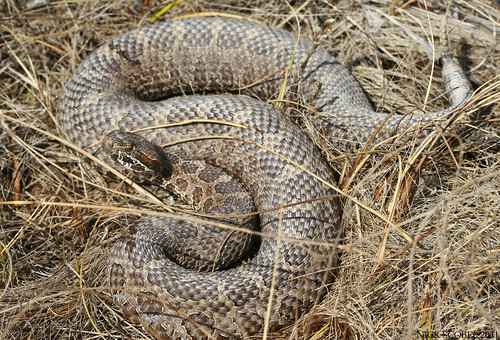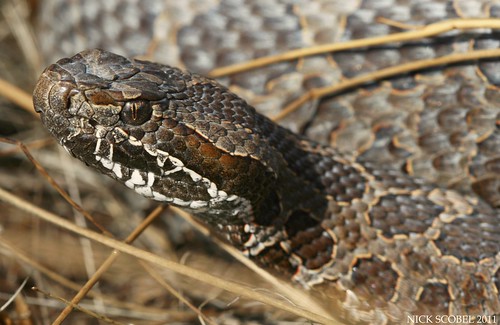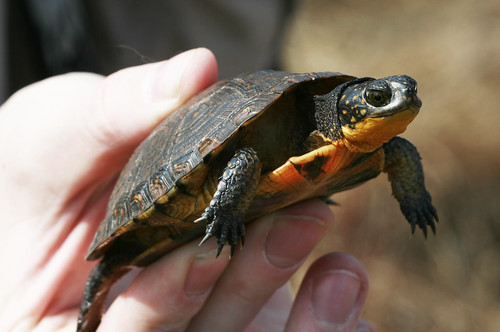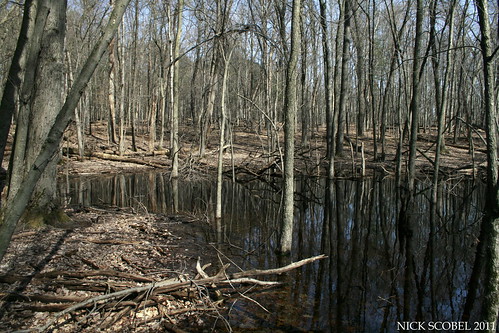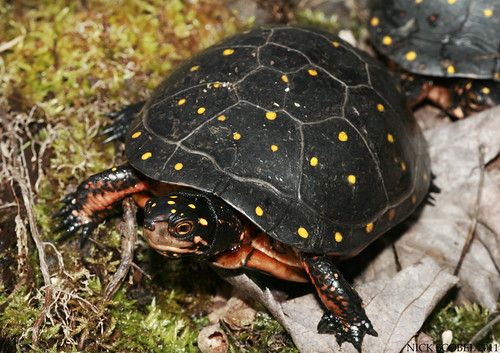With this area freshly burned, crayfish burrows and anything else on the surface was extremely visible. It didn't take us long to find our target, and Jason spotted this unlikely pair.
What is so odd about this scene is that Blue Racers have been documented to be a predator of Massasaugas. However, this Blue Racer was only about two feet long and would have had a tough time taking down an adult rattlesnake. What's even more interesting is that this pair probably shared the same burrow for the winter, as the racer quickly darted down a crayfish burrow a foot or two away. After photographing the rattlesnake, she slipped down the same exact burrow.
Eastern Massasauga Rattlesnake - Sistrurus catenatus catenatus
After letting this big girl on her way, we pushed farther back into then fen. Less than a few minutes later, I spotted this rather thin adult on the crawl about fifteen yards ahead of us.
We quickly snapped some shots of this animal without disturbing it and moved. I spied a few large patches of Round-lobed Hepatica nearby and headed towards them, before I could get my camera gear out Jason called out that he had found yet another Massasauga. I quickly ran over to him to see another mud covered adult coiled in the open. We snapped a few photos without disturbing the snake and I went and snagged a few shots of the hetatica.
Round-lobed Hepatica - Hepatica nobilis
We kicked up a few other common snakes including Garter & Ribbon Snakes and decided it was best to move on. Jason said he had seen some nice Blue Racer habitat on our way in, so we decided to first pit stop there to see if we could find one. We arrived at a small meadow bordered by shrubs and forest, it looked ideal. Although racers have declined significantly in the southeast portion of the state, there are still some pockets of good habitat that hold good numbers of them. A few minutes passed and on our way out Jason called out, "Big racer!"
Near a small shrub was this beast, everything of five feet in length. It never ran, but rather held its ground and flattened its neck vertically like an Indigo Snake and hissed loudly. It was definitely one of the nicest looking Blue Racers I've had the opportunity to see here in Michigan.
Blue Racer - Coluber constrictor foxii
Shortly before the picture above was taken, the snake struck right at Jason and whacked his camera sqaure on, we both shared quite a laugh. Jason's dogs Cid & Joy seemed to give the snake no attention and were too busy chasing each other around in the field. After photographing this snake, we returned to our cars and figured out what our plan of attack was next.
We both knew of a few sites nearby and decided to give a spot a try where Jason had seen a juvenile rattlesnake the year before in the middle of summer. A short drive and we arrived at our location and set out.
Purple Pitcher Plant - Sarracenia purpea
This is an extremely high quality fen, with many interesting plant species including pitcher plants & sundews. I had been to this area the year before and only managed to find some garters, a few water snakes, and a nice case of Poison Sumac. The clouds had parted rather nicely, and the temps had reached the low 70s by this point in the afternoon. We spread out a little bit and as I was roundng a small patch of sedge & poison sumac a bit of patterning caught my eye.
I quickly called out, "I've got one right here!" This rattlesnake was in the most classic coil I've ever seen from an individual of this species. This snake also was not caked in mud and dirt likes the ones at the other site were, it was absolutely gorgeous. This snake was so cooperative photos and never even budged or rattled once while I shot some photos of her.
Eastern Massasauga Rattlesnake - Sistrurus catenatus catenatus
After shooting this gorgeous snake for a few minutes, I moved on but was quickly interrupted as I spotted this absolute bruiser about twenty feet away from the first snake. This snake made a hasty exit down into the sedges and likely into a crayfish burrow.
After this snake made an exit, we spread out quite a bit into the fen and stirred up one or two garter snakes. As we were heading back to the cars, I was alerted by a short, high pitched buzz near my feet and looked down to see our sixth and final rattlesnake of the day a few feet from my left foot hidden in some sedges.
This snake buzzed angrily and then quickly disappeared into the sedges. 6 Eastern Massasaugas in a single day tied my record for one day, and I believe Jason more than doubled the amount of Eastern Massasaugas he had seen in Michigan in the past few years in a single day. So to say the least, it was a pretty incredible day. Multiple rattlesnake days have been commonplace for me so far this spring, and I've already seen well over 20 individuals in the month of April. A few weekends back, I had to chance to take out a group of enthusiastic young herpers ranging from ages 5-12 for rattlesnakes. Their parents; Cara and Marty, tagged along to ensure the kids were safe. We met up with Chris, Colin, and Matt Boguslawski and Curtis Hart joined as well. With a large contingent, we liked our chances at scoring a rattlesnake. With the sun shining, we set out around 10:30AM and within a few minutes Curtis spotted a large adult emering from its crayfish burrow near a stream bank.
We simply snapped a few photos of this snake from a distance and moved on. A little further up the trail, we spotted our second rattlesnake of the morning, a familiar female that I've seen several times this spring and regularly over the past years. She was on the crawl in the open along the edge of a tamarack swamp.
We spent a few minutes watching her make her way through the sedges. The kids asked tons of questions about Massasaugas and I tried to do my best to keep up! We circled the trail and came back to where we had seen the large female emerging from her burrow earlier in the morning. She was nowhere in site until I turned around and spotted her basking in the open on the opposite side of the trail. After getting a good look at her out in the open, we concluded that she was gravid as indicated by her overly swollen back half of the body. We snapped some shots of her and then she decided the wanted to cross back to the edge of the opposite side of the trail. The kids and everyone admired her as she made her away across the trial.
I absolutely love this photo. You can see how amazed the kids were, I only wish so many young kids shared the same interest & passion for wildlife and nature that these kids do. A little later on, one of the youngsters called out, "Rattlesnake!" I couldn't even see where he was looking, but as he pointed to the base of a shrub on the edge of the tamarack swamp I noticed a well patterned adult Massasauga coiled in the sun. It amazes me how young kids have the ability to spot things in this manner.
Eastern Massasauga Rattlesnake - Sistrurus catenatus catenatus
The last observation that I'll share from this spring was a few weekends back. It was a cool, blustery morning with temps in the low 50s and wind gusts up to 40mph. I decided to go for a walk at a local area and wasn't expecting to see much. As I was walking a trail, I noticed a flash of color that caught my eye. I looked over to the edge of the trail to see this in some sedges along the edge of the tamarack swamp.
At first I wasn't quite sure what I was looking at. The dark coloration looked like dark garters I've seen in the area, but once I looked at it a little more I was pretty excited to say the least.
Eastern Massasauga Rattlesnake - Sistrurus catenatus catenatus
This is a melanistic Eastern Massasauga Rattlesnake. Melanism is genetic abnormality that causes higher amount of dark pigment due to the presence of melanin, the result is an almost completely black animal. This is an uncommon occurance in Eastern Massasaugas, but some populations have large amounts of melanistic individuals. They can be completely black, or have faint traces of patterning as with this individual. It was one of the best finds I've had over the past few years, and I'm glad I finally got the chance to get some good photographs of one. It's been a busy April, so thats all for now. Until then, happy herping!


